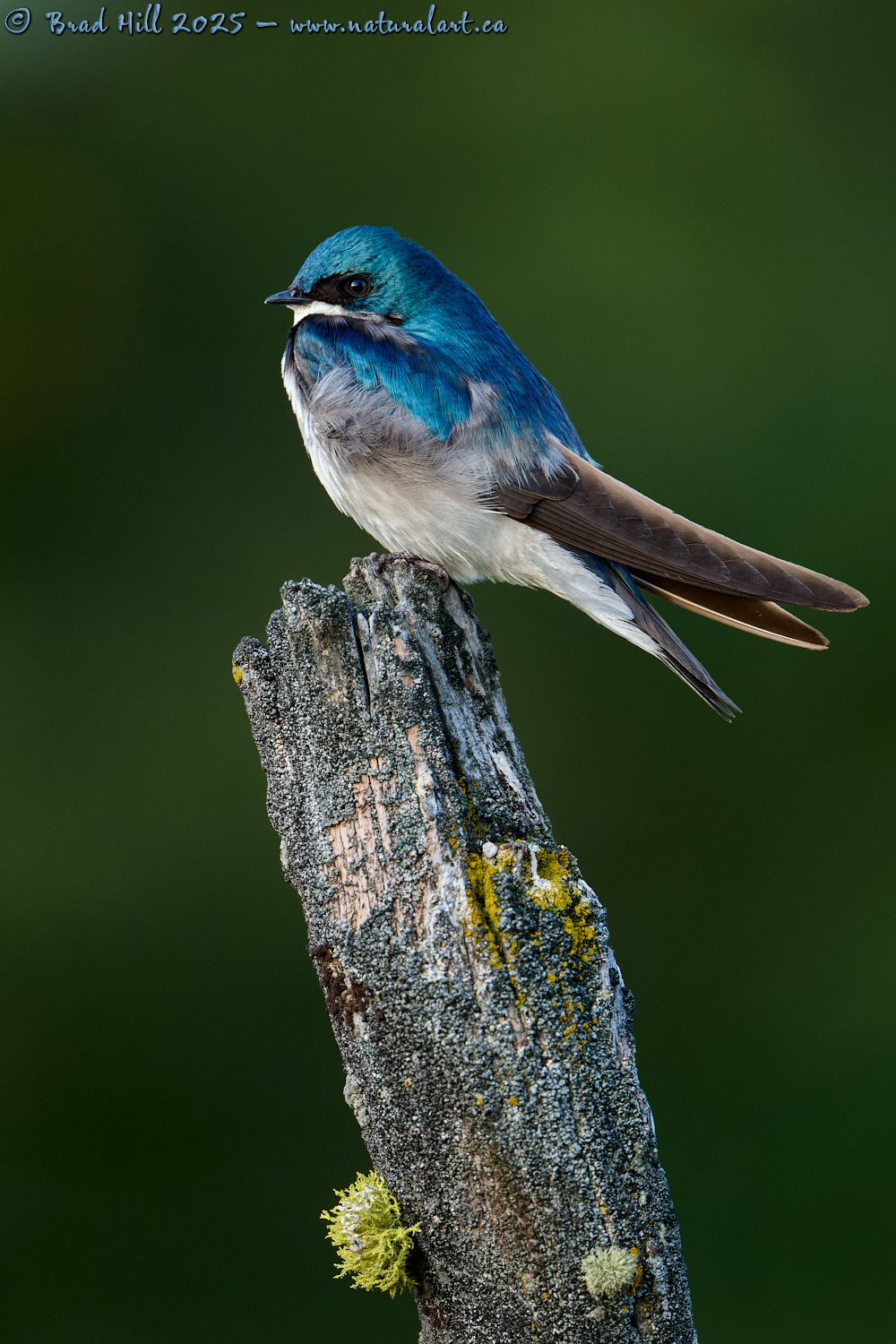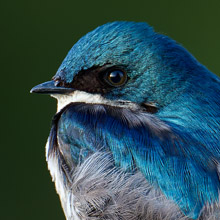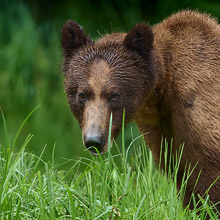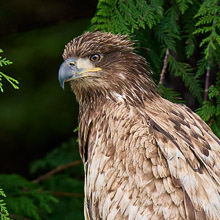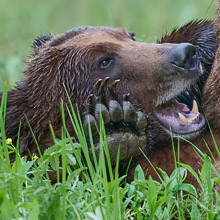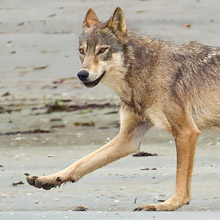Availability: Undetermined - Enquiries?
In the Field
Blue, Brown and White on Green. Findlay Creek, British Columbia, Canada. May 14, 2025.
I'm a long ways away from being a specialist in (or particularly skilled at) bird photography, but I certainly appreciate the beauty of many species of birds. And in my books - and when caught in the right light - Tree Swallows are among the most beautiful of birds (you know...stunning plumage but without crossing over to the gaudy side). Tree Swallows can be tricky to photograph, largely because of the huge brightness range of their plumage, especially if they are caught in direct sunlight. Of course, the latest digital cameras have a can record a very wide brightness range (i.e., their sensors have a very wide dynamic range)...but Tree Swallows still push those sensors to their limits!
I captured this male Tree Swallow in beautiful dawn sunlight while on one of my regular sunrise "camera walks" on our property. At the time I was walking around with my Z 9 paired up with a Nikkor Z 600mm f6.3S (carried on my chest using a Mr. Jan Gear Lens Carrier System). In many respects this image was little more than a "point-and-shoot" exercise - all it involved was finding the bird in the right light, grabbing my camera out of the carrier system (which takes about one second!), focusing, adjusting the exposure to avoid blowing out the highlights, and...click (actually it was click, click, click, click!).
Over the summer of 2025 one of my behind-the-scene projects involved doing a LOT of image culling, including images up to two decades old. During this task I was actively mulling over the advances in both the hardware and software associated with professional wildlife photography (while comparing recent images - including this Tree Swallow image - with similar images captured up to 20 years ago). And...you know what? The final result (after image processing) today is virtually no better than 20 years ago! Yes, the images are of much higher resolution and thus you can do a LOT more with them, but the quality is very similar.
Now that said, there are some still some huge differences in photography today that have been driven by advances in hardware and software. To begin with - and largely owing to improved autofocus, better image stabilization systems, increased dynamic range of our image sensors, improved ISO performance, and much smaller and lighter super telephotos - the image capture process is dramatically easier and simpler. My Tree Swallow shots of 20 years ago required lenses to be supported on tripods and involved the use of flash-fill to reduce the contrast, thus enabling the sensor to capture the brightness range of the swallow (which I can now easily do in post-processing).
And...once back in my home digital darkroom the advancement in the software I use in post-processing (including dramatically more efficient masking techniques) means I can produce my final output in a small fraction of the time it took twenty years ago. This image probably took me 15 minutes to process...twenty years ago it would have taken me closer to two hours! Nice.
The net result of the hardware and software developments in digital photography over the past few decades is that because it's so much easier and quicker to get to a satisfactory end result many more people are doing so! As a working professional wildlife photographer I have to wonder if this is necessarily a good thing! 😉
Here's a larger version (4800 pixel) of this proud and bold Tree Swallow:
• Blue, Brown and White on Green: Download 4800 pixel image (JPEG: 5.5 MB)
ADDITIONAL NOTES:
1. These images - in all resolutions - are protected by copyright. I'm fine with personal uses of them (including use as desktop backgrounds or screensavers on your own computer), but unauthorized commercial use of the image is prohibited by law. Thanks in advance for respecting my copyright!
2. Like all photographs on this website, these images were captured following the strict ethical guidelines described in The Wildlife FIRST! Principles of Photographer Conduct. As such, no baiting or any form of attractant was used and, as always, we attempted to minimize our impact on the ongoing behaviour of the subjects. I strongly encourage all wildlife photographers to always put the welfare of their subjects above the value of their photographs.
Behind the Camera
Blue, Brown and White on Green. Findlay Creek, British Columbia, Canada. May 14, 2025.
High Efficiency* Compressed RAW (NEF) format; ISO 1250.
Nikon Z 9 paired with Nikkor Z 600mm f6.3S. Hand-held. VR on in Sport mode. 3D-tracking AF area mode with subject detection on "Birds" mode.
1/1250s @ f7.1; -0.7 stop compensation from matrix-metered exposure setting.
At the Computer
Blue, Brown and White on Green. Findlay Creek, British Columbia, Canada. May 14, 2025.
Initial noise reduction and capture sharpening on the .nef (raw) file using the DeepPRIME XD2S algorithm of DXO PhotoLab 8.7 Elite (using the appropriate lens/camera optical module).
Subsequent adjustments to the adjusted linear DNG file (exported from PhotoLab) and conversion to 16-bit TIFF file (and JPEG files for web use) - including all global and selective adjustments - made using Capture One Pro (build 16.6.3). In the case of this image the only global adjustment made was to overall contrast (using a Levels adjustment). Selective local adjustments performed using Capture One Pro's layers and masking tools. In this case numerous small adjustments and minor tweaks were made on 7 separate layers, with the tweaks being associated with "exposure balancing" and contrast adjustments (such as adjustments to brightness, clarity, highlights, shadows, etc.).
Photoshop modifications included insertion of the watermark and/or text.
Conservation
Blue, Brown and White on Green. Findlay Creek, British Columbia, Canada. May 14, 2025.
Species Status in Canada*: This species is not designated as at risk.
The Tree Swallow (Tacycineta bicolor) is a common insect-eating aerobatic specialist found across much of North America. Tree Swallows nest in abandoned cavities in trees or in nest boxes provided for them by humans. The breeding range of the Tree Swallow is expanding southward and overall their populations appear to be increasing.
This Tree Swallow was photographed in the Columbia Valley of the East Kootenays of British Columbia, Canada. While this species is not currently considered at risk in this region, virtually all of Canada's aerial insectivores (to which the Tree Swallow is a member) have been exhibiting steep population declines in recent years. While the cause isn't fully understood, many believe that changes to the seasonality of their insect prey (including changes to when they are available in large numbers as prey) is thought to be the proximate cause of the decline. Many believe that this change in the seasonal abundance of their prey is being driven by climate change.
*as determined by COSEWIC: The Committee on the Status of Endangered Wildlife in Canada













